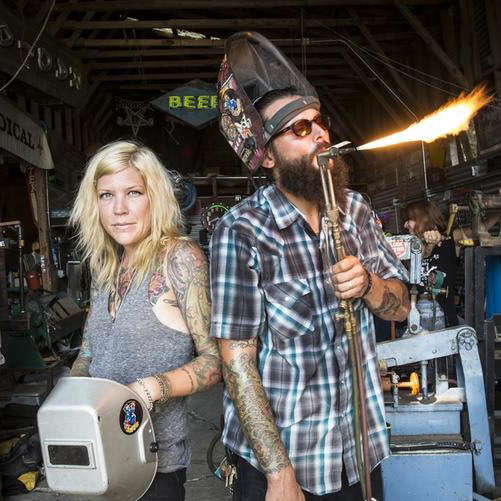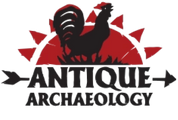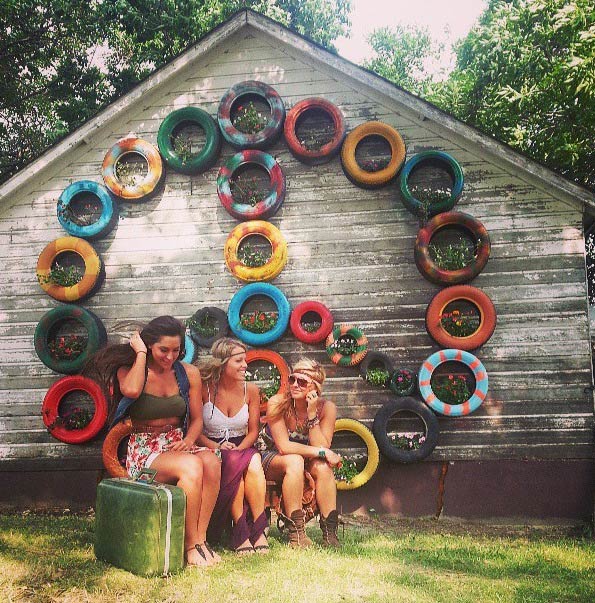BLACKOUT SIGNS: THE ART OF OLD-FASHIONED ADVERTISING

Small town metal man Jay Gordon illuminates main streets and music festivals with his hand-made neon signs created in a 1930s barn near Austin, Texas.
Do you know those YouTube videos of people cooking eggs on the pavement? That’s how hot it feels in San Marcos, Texas this morning as Jay Gordon, his wife Darcy, and his band of neon sign builders sprint from their air-conditioned trucks into their usual spot for breakfast tacos. The team is feeling the burn in more ways than one after working late last night on a project for Lollapalooza, burning the midnight oil in their workshop, a restored, bare-bones barn on the outskirts of Austin. After a few cigarettes and some chorizo, it’s time to head back to the barn, crank some Slayer, and melt some metal at Blackout Signs and Metalworks.
A self-taught sign maker, Jay started his business in San Marcos, a small college town 30 minutes south of Austin. His neon creations began to buzz and blink around town and caught the attention of some Red Bull reps in town. They met Jay at his barn to offer him his first big job — designing and building a piece for their local Flutag event in downtown Austin. Great news! The not-so-great news: they needed the sign in 24 hours.

“We completed the job and have been on their shortlist ever since,” says Jay. “That job placed us in front of ACL Fest, Google, Spotify, Virgin Mobile, and a growing list of national companies looking for something a little more funky and unique. We also built a replica 10’ tall animated Pontiac sign in collaboration with Big Dog Neon. It was used in a Transformers movie, which was insane!”
What’s more mind-blowing than that? Each of Blackout’s one-of-a-kind signs is created in a restored barn from the 1930s.
The barn houses an honest man’s workshop. (Imagine what your gramps had out back but with more spare lightbulbs.) No computers or high-tech gadgets. Not even an AC unit to cut the blistering heat. Nope, it’s just the basics in here: ashtrays scattered about, cold beer in the fridge, and vintage metalworking tools on every flat surface. Blackout operates as a 1960s sign shop with a fabrication, a finish out, and an assembly side. This stuff gets built, lettered, and completed wherever there is room. (Fun Fact: Jay’s first shop was in a small garage just large enough to accommodate a Model T!)

“Before we moved in, we had to patch up all the cracks and leaks and chase away the raccoons and snakes,” explains Jay. “The barn was full of junk. There was no electricity, heat, or plumbing. It was a blank slate for Blackout. We cleaned it out to the bare walls and made it our new home. That sure didn’t stop the critters from coming back at night and walking across our freshly painted signs though!”
At its core, Blackout is a totally custom design business. They sweat, measure twice and cut once, use obsolete tools from WWII, and make no excuses. Nothing is computer perfect; flaws are part of the art. Luckily, people respond to that.
Much like the shop, the crew is also old school and worn in, with years of experience. Gabe Hedrick, Jason Lambert, David “Falco” Perez, and Darcy Hanna, Jay’s wife of 13 years and “den mother” to the crew, complete the Blackout dream team. With six or seven projects going on at a time, it’s incredibly important for the shop vibe to be just right.
“It’s like being in a band — without good players, you have a crap band,” explains Jay. “Gabe, Jason, and Falco are guys I don’t have to babysit or guide. They’re familiar enough with the anatomy of neon and they’re experts at restoration so I know exactly what to expect from them: high quality, hand-drawn, hand-cut and hand-painted advertising. As a crew, what turns our crank is creating a piece that was better than the last.”

“We’ve got a small but passionate group of fabricators and designers in the shop,” says Darcy. “There’s a collective sense of brotherhood and accomplishment from the first design to the delivery. Getting to see our work buzzing and blinking across the country inspires us to keep our momentum.”
For Jay, the best part about making these buzzing signs is the final installation. He loves watching how a sign built in an old barn can change the visual landscape that surrounds it.
“Once we install the sign, a few nights later I’ll drive past it with my son and just stare,” admits Jay. “What really makes me proud about the work we do is hanging our hand-made sign next to one with modern LED lights. It’s a side-by-side comparison of what’s well done and what’s a cheap imitation. Every place we install a piece of our work, we help authenticate the scene, whether it’s a downtown main street or a big music festival. It’s an incredible responsibility.”
They also have a responsibility to honor the time-tested methods of the neon gods who came before them. That’s why when constructing the base of these neon signs they don’t mess with the materials.
“Signs that were fabricated in the ’40s or ’50s are still around for a reason,” says Jay. “They were built by craftsmen who took pride in their work. We keep our materials list short: sheet metal, rivets, and heat.”
Just don’t ask Jay to name his favorite project; you might as well be asking him what his favorite color of neon is. But if you ask nicely, you might get him to name of few of the stand-outs:
- The repurposed 1950s “LIQUOR” sign they created for Zelick’s, a local bar that once was an old gas/service station.
- The lowrider ice cream pushcart contracted by Absolut Vodka for SXSW had hydraulics, a self-contained onboard air compressor, music, lighting, and automotive candy paints.
- The rotating spaceship sculpture for Mellow Mushroom in Florida created out of 2,000 pounds of belts that used to power old machine shop equipment, license plates, a WWII aircraft nosecone, saw blades, vintage headlights, bumpers, and rotating colors throughout.

The crew testing out the Absolut Vodka paletas cart for SXSW
When they want to add a few more details to those creations, they go dig around in the boneyard behind the barn for pieces they’ve collected over the past eight years. There’s a treasure in that pile: glass housing, mechanical animators, architectural ironwork, and even pieces of Lyndon B. Johnson’s communications tower.
“We went out to Lyndon Johnson’s ranch for a project for the LBJ Museum in San Marcos to collect pieces from the antenna tower on the property. It was used by LBJ to communicate with the White House during his presidency. We brought the pieces back to the barn and incorporated them into the sign. It gave me goosebumps to hold history like that in my hands. To the untrained eye, it’s just a piece of angle iron, but to learn that that angle iron held up a tower which was used by one of our presidents is a reminder that we’re not just in the neon sign business, we’re in the preservation business. There’s a story behind every single piece we create.”
Jay has always felt he was born at the wrong time. Creating signs with the time-tested methods he uses allows him to revisit moments from the past and to continue the tradition of illuminating the art of hand-crafted advertising.
If you have a project request for Blackout, drop them a line!
Photos from Blackout Signs and Metalworks




